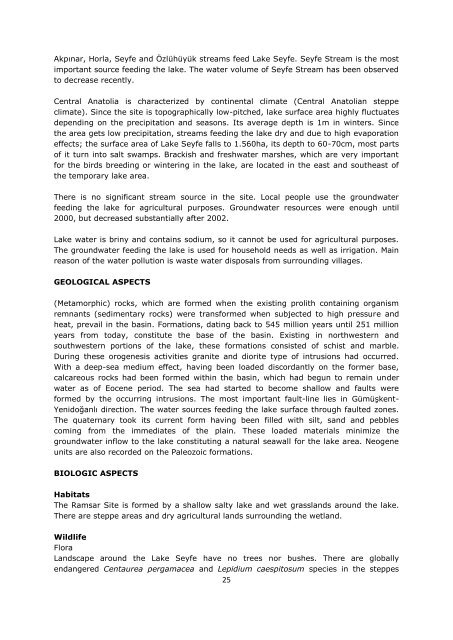Ramsar Sites of Turkey - Ramsar Convention on Wetlands
Ramsar Sites of Turkey - Ramsar Convention on Wetlands
Ramsar Sites of Turkey - Ramsar Convention on Wetlands
Create successful ePaper yourself
Turn your PDF publications into a flip-book with our unique Google optimized e-Paper software.
important source feeding the lake. The water volume <str<strong>on</strong>g>of</str<strong>on</strong>g> Seyfe Stream has been observed<br />
to decrease recently.<br />
Central Anatolia is characterized by c<strong>on</strong>tinental climate (Central Anatolian steppe<br />
climate). Since the site is topographically low-pitched, lake surface area highly fluctuates<br />
depending <strong>on</strong> the precipitati<strong>on</strong> and seas<strong>on</strong>s. Its average depth is 1m in winters. Since<br />
the area gets low precipitati<strong>on</strong>, streams feeding the lake dry and due to high evaporati<strong>on</strong><br />
effects;; the surface area <str<strong>on</strong>g>of</str<strong>on</strong>g> Lake Seyfe falls to 1.560ha, its depth to 60-70cm, most parts<br />
<str<strong>on</strong>g>of</str<strong>on</strong>g> it turn into salt swamps. Brackish and freshwater marshes, which are very important<br />
for the birds breeding or wintering in the lake, are located in the east and southeast <str<strong>on</strong>g>of</str<strong>on</strong>g><br />
the temporary lake area.<br />
There is no significant stream source in the site. Local people use the groundwater<br />
feeding the lake for agricultural purposes. Groundwater resources were enough until<br />
2000, but decreased substantially after 2002.<br />
Lake water is briny and c<strong>on</strong>tains sodium, so it cannot be used for agricultural purposes.<br />
The groundwater feeding the lake is used for household needs as well as irrigati<strong>on</strong>. Main<br />
reas<strong>on</strong> <str<strong>on</strong>g>of</str<strong>on</strong>g> the water polluti<strong>on</strong> is waste water disposals from surrounding villages.<br />
GEOLOGICAL ASPECTS<br />
(Metamorphic) rocks, which are formed when the existing prolith c<strong>on</strong>taining organism<br />
remnants (sedimentary rocks) were transformed when subjected to high pressure and<br />
heat, prevail in the basin. Formati<strong>on</strong>s, dating back to 545 milli<strong>on</strong> years until 251 milli<strong>on</strong><br />
years from today, c<strong>on</strong>stitute the base <str<strong>on</strong>g>of</str<strong>on</strong>g> the basin. Existing in northwestern and<br />
southwestern porti<strong>on</strong>s <str<strong>on</strong>g>of</str<strong>on</strong>g> the lake, these formati<strong>on</strong>s c<strong>on</strong>sisted <str<strong>on</strong>g>of</str<strong>on</strong>g> schist and marble.<br />
During these orogenesis activities granite and diorite type <str<strong>on</strong>g>of</str<strong>on</strong>g> intrusi<strong>on</strong>s had occurred.<br />
With a deep-sea medium effect, having been loaded discordantly <strong>on</strong> the former base,<br />
calcareous rocks had been formed within the basin, which had begun to remain under<br />
water as <str<strong>on</strong>g>of</str<strong>on</strong>g> Eocene period. The sea had started to become shallow and faults were<br />
formed by the occurring intrusi<strong>on</strong>s. The most important fault- -<br />
<br />
The quaternary took its current form having been filled with silt, sand and pebbles<br />
coming from the immediates <str<strong>on</strong>g>of</str<strong>on</strong>g> the plain. These loaded materials minimize the<br />
groundwater inflow to the lake c<strong>on</strong>stituting a natural seawall for the lake area. Neogene<br />
units are also recorded <strong>on</strong> the Paleozoic formati<strong>on</strong>s.<br />
BIOLOGIC ASPECTS<br />
Habitats<br />
The <str<strong>on</strong>g>Ramsar</str<strong>on</strong>g> Site is formed by a shallow salty lake and wet grasslands around the lake.<br />
There are steppe areas and dry agricultural lands surrounding the wetland.<br />
Wildlife<br />
Flora<br />
Landscape around the Lake Seyfe have no trees nor bushes. There are globally<br />
endangered Centaurea pergamacea and Lepidium caespitosum species in the steppes<br />
25
















